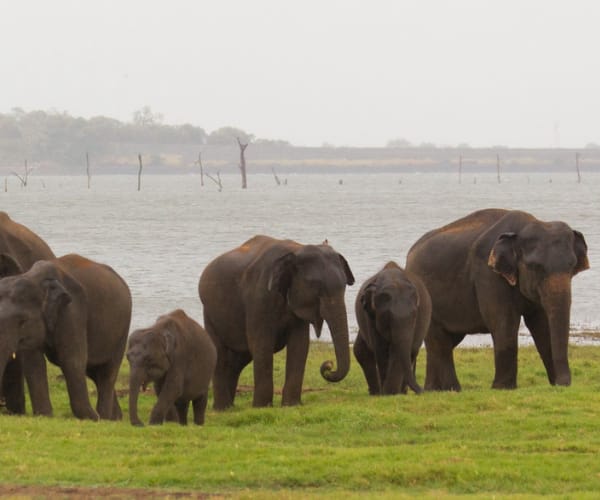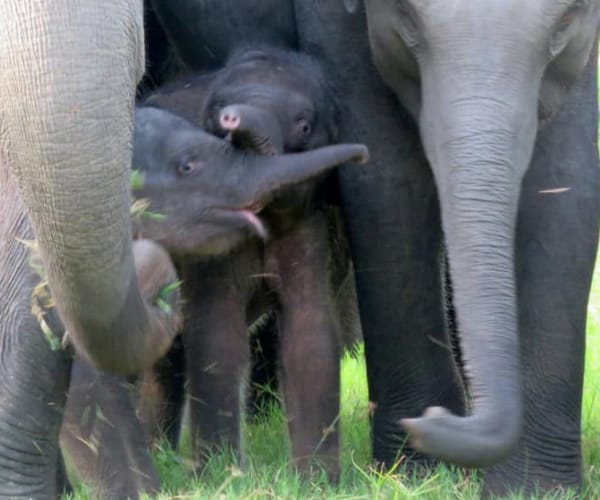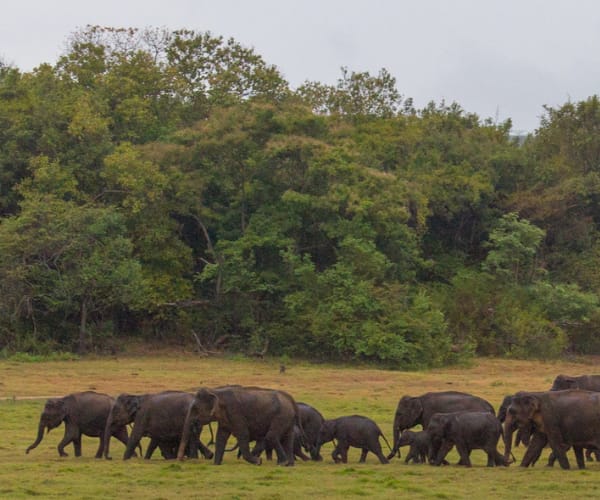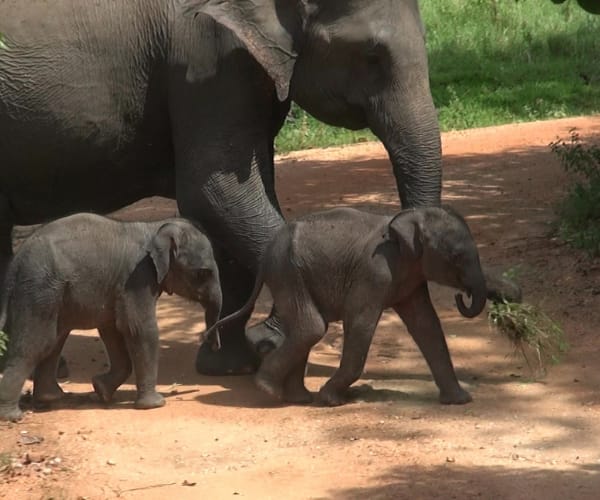
Aug 20 2021.
views 1633A QUICK TAKE
ISSUE: One of the ‘Wildlife Wonders of the World’, The Great Elephant Gathering of Minneriya National Park, is at risk due to human interference in an age-old natural system. The grass that emerges on the Minneriya tank-bed in the dry season, which elephants gather to feed on, are lately being submerged as the tank is now used in the dry season to store water from Moragahakanda, to transport for agriculture in the East.
IMPACT: In 2018 the tourism benefits from The Gathering were over ~ Rs. 4 billion. The spectacle of large groups of elephants is receding and the major tourist attraction is disappearing.
SOLUTION: The water levels of Minneriya must not be manipulated during the dry season. Irrigation experts must develop a more sustainable method of transporting water to the East, which does not jeopardise the tourism and community benefits from this high-profile wildlife event.

Image courtesy of Dev Wijewardane
SRI LANKA TOURISM
Blessed by Nature
In 2018, at its peak, Tourism earned Sri Lanka US $4.4 billion (Source: Oxford Business Group). In addition, in 2017, according to The World Travel and Tourism Council, tourism generated 404,000 direct jobs for the people of Sri Lanka, equal to 5.1% of national employment.
It is no secret that Sri Lanka’s main allure is its many natural attractions. In 2015 Sri Lanka won the “ Best Eco-Tourism Destination” award at the World Tourism Expo in Shanghai China, in 2019 Forbes ranked Sri Lanka first in the category of ‘Asia’s Best Nation for Wildlife Tourism’ by Top 10 Asia and Best Destination for Safari Outside of Africa, and in 2020 Sri Lanka was selected as one of CNN Travel’s 20 best places to visit in 2020.
Sri Lanka has always been famous for its abundant natural beauty. In addition to the lush tropical jungles and forests, lakes and rivers, the country is home to an incredible diversity of wildlife including leopards, bears, whales, birds, reptiles and, of course, elephants. Thanks to this, all packed into a small island with good tourism infrastructure, coupled with its strategic position in Asia, Sri Lanka has made a name for itself as one of the best wildlife tourism destinations in the world.

Images courtesy of Mr Rohan Wijesinha & Dr Sumith Pilapitiya
THE “GATHERING”
One of the Wildlife Wonders of the World
Each year, during the dry season, Minneriya National Park attracts what Lonely Planet refers to as “One of the 10 Greatest Wildlife Wonders of the World”. Beginning in May, large numbers of elephants gather on the grasslands of the lake bed at Minneriya, numbering as many as 400 at its peak, from August to September, in what has been termed as ‘The Gathering’. It draws millions of local and foreign tourists to the Park each year.
Dr Sumith Pilapitiya, former Director-General of the Department of Wildlife Conservation, and one of the country’s leading elephant researchers, has been studying ‘The Gathering’ for many years and has concluded that the elephants come in their number in search of, not water, but of the lush new grasses of the lakebed, as they have a higher protein content than mature grasses. With the release of water from the reservoir at the start of the dry season, for the irrigation of agricultural lands, grasslands emerge on the exposed lakebed and, with it, come the elephants. The inviting waters of the Minneriya tank are just a bonus for them, and they make good, and entertaining, use of it.
The elephant herds disperse again once the dry season ends, and the rains of the north-eastern monsoon begin to fill the reservoir once more.
MORE THAN JUST A ‘GATHERING’
Dr Pilapitiya observes that ‘The Gathering’ is not just a place to see elephants in large numbers but also one of the best places to observe “unique natural biological behaviours of elephants”, which are rare and highly valued occurrences not just for researchers, but also for wildlife lovers and photographers.
ALL ABOUT TO END?
In 2018, with the construction of the Moragahakanda Reservoir, unseasonal water releases into Minneriya have resulted in the fluctuation of water levels in the tank. Dr Pilapitiya’s observations have confirmed that these fluctuations have resulted in a reduction of the elephant populations at The Gathering.
This has resulted in ‘The Gathering’, one of 400 or more elephants at a time, transforming into scattered groups of barely 200, at the most; no longer the ‘spectacle’ it once was, but one that can be observed in other Asian countries as well.
“Minneriya is the best site not only to observe large herds of elephants but also a unique location to see interesting elephant social behaviour. There is no other such site among the 13 Asian Elephant Range States and has been a magnet for attracting tourists, foreign and domestic, in their thousands.”
- Dr Sumith Pilapitiya-
(Former Director-General of Sri Lanka’s Wildlife Conservation Department (DWC)

Image courtesy of Dev Wijewardane
WORTH ITS WEIGHT IN GOLD
As per a study undertaken by Srilal Miththapala, founding member of Sri Lanka Tourism Alliance, back of envelope calculations estimate the total economic worth of The Gathering to be well over ~ Rs. 4 billion or US$ 22 million, in 2018. Disrupting the natural cycle may result in the country losing Rs. 4 billion in tourism benefits to the National economy each year.
No agricultural project irrigated with water from Minneriya, during the dry season, will contribute to even 1% of the present economic value of ‘The Gathering’. Owing to the popularity of The Gathering, Minneriya & Kaudulla National Parks combined, rate as the #2 Wildlife attraction visited by tourists each year, second only to Sri Lanka’s premier wildlife destination, Yala National Park (Source: Sri Lanka Tourism Development Authority). Furthermore, The Gathering is on the travel itinerary of just about every foreign tourist visiting the island during the 4-month period between June and September. It benefits not only the ticket sales of Minneriya and Kaudulla National Parks, but also the incomes of many others including safari jeep drivers, hotels, eateries and even the roadside fruit and king-coconut sellers, who manage to make a few hundred rupees to feed their families for the day, from the tourists who stop by.
Any threat to the survival of ‘The Gathering’ will have severe consequences not only on Sri Lanka’s position as one of Asia’s best destinations for wildlife tourism but also on its local and national economies.
THE WAY AHEAD
Sensible collaboration between Government Departments and Tourism Stakeholders ‘The Gathering’ is too important to lose. Along with the elephants, it would wipe out vast amounts of FX revenue and thousands of jobs from the local economy. With the construction of the Moragahakanda reservoir water is released to Minneriya during the dry season for irrigation in Kantale and beyond. These unseasonal water releases, submerge the grasslands that are used as fodder by the elephants which is the cause of the current disruption to The Gathering.
Due to reservoir elevations, Minneriya needs to be filled to 70% of its capacity for gravity-flow into Yodha Ela, which then transports the water to the East. Sri Lanka’s competent civil and hydrological engineers should be consulted, to develop a better solution to feed the Minneriya water to Yodha Ala, instead of having to maintain the tank’ water levels at 70% capacity, so that the irrigation needs of the East can be met without jeopardising the tourism benefits of The Gathering. A cost-benefit analysis should be conducted on the project to include the opportunity cost to the Sri Lankan economy of losing The Gathering.
THE FUTURE OF TOURISM IN SRI LANKA
Under the weight of the economic burden stemming from the Covid-19 pandemic, the agricultural needs of the population have rightfully taken center stage right now. However once the pandemic is brought under control, international tourism will resume. Sri Lanka must not forget the country’s tourism potential by destroying the very things that attract tourists to our shores. Being a country featuring predominantly ‘nature-based tourism’, Sri Lanka’s tourism industry and operators can and should play a vital role in the conservation of Sri Lanka’s nature and wildlife; as the future sustainability of the industry hinges upon it. The Gathering of elephants at Minneriya, as well as all wildlife, have an enormous economic potential for generating much needed foreign exchange revenue for Sri Lanka and we must protect these important elements of our Natural Heritage as economic assets of national importance.

Image courtesy of Mr Rohan Wijesinha & Dr Sumith Pilapitiya
Sri Lanka Tourism Alliance will introduce the ‘Conservation Tourism’ webinar series to be hosted in the coming weeks. The series will discuss the importance and benefits of wildlife and nature conservation, as it applies to tourism in Sri Lanka, and hear from some of the experts in the field. Keep an eye out on the Sri Lanka Tourism Alliance website and social media for further details!
Text and photos courtesy Sri Lanka Tourism Alliance
3 Comments
Gamarala says:
Aug 22, 2021 at 11:48 pmVery soon a time may come when these large herds will have to be culled as done in Game parks in Africa to sustain a healthy herd. Sri Lankan wild elephants are running out of habitat (space) and food to sustain a healthy and viable herd. This is a scientific fact.
shantha says:
Aug 28, 2021 at 06:16 pmNeed to protect nature of wildlife it is our heritage
Chandra Fernando says:
Aug 30, 2021 at 05:37 pmThe elephant MUST be protected and given sanctuaries to live. New hotels and other tourism projects MUST be curtailed to let the elephants have a well protected habitat. Furthermore, elephants must not be fastened with electric lights during Peraharas. It is cruel to do so. There may be other forms of illuminations in this day and age to provide other forms of "lighting" that do not involve dressing them with electric lights.